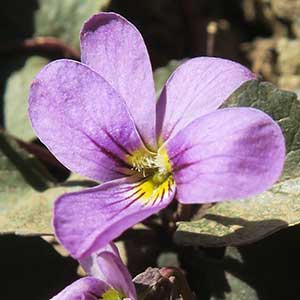Viola rotundifolia
Viola flettii
early yellow or roundleaf yellow violet, round-leaf violet, roundleaf yellow violet, violette à feuilles rondes
Flett's violet, Olympic violet, rock violet
1–3, ascending to erect, mostly glabrous, on caudex from fleshy rhizome.
basal, 2–5, prostrate to ascending, often overlapping basally;
stipules linear-lanceolate, margins entire, apex acute;
petiole 2–8 cm, pubescent;
blade unlobed, orbiculate, reniform, or ovate, 2–12 × 1.5–9 cm, base cordate, margins crenate to serrate, sometimes glandular, ciliate or eciliate, apex rounded to acute, surfaces usually pubescent throughout or concentrated proximally on both surfaces.
basal and cauline;
basal: 1–3;
stipules linear-lanceolate, margins entire or with glandular processes, apex acuminate;
petiole 1.5–9.7 cm, mostly glabrous;
blade purple-tinted and –veined, broadly reniform to ovate, 0.9–2.4 × 1.2–4 cm, base cordate, margins finely crenate-serrate, eciliate, apex acute to obtuse, surfaces glabrous or sparsely pubescent along veins adaxially;
cauline similar to basal except: stipules ovate to lanceolate, margins entire or shallowly laciniate;
petiole 0.7–5.9 cm, usually glabrous;
blade 0.8–2.1 × 1.2–3.1 cm.
1.5–7 cm, usually pubescent.
1.8–7.1 cm, usually glabrous.
sepals lanceolate to ovate, margins ciliate or eciliate, auricles 0.5–1 mm;
petals deep lemon-yellow on both surfaces, lower 3 brownish purple-veined, lateral 2 bearded, lowest 8–11 mm, spur yellow, gibbous, 1–2 mm;
style head beardless; cleistogamous flowers on prostrate or partially subterranean rhizomes or on racemelike, nonrooting, and usually leafless branches growing from rhizome apex.
sepals lanceolate, margins eciliate, auricles 0.5–1.5 mm;
petals soft reddish violet on both surfaces, all with yellow area basally, lower 3 dark violet-veined, lateral 2 bearded, lowest with white around yellow area, 10–15 mm, spur yellow, gibbous, 0.5–2 mm;
style head bearded; cleistogamous flowers axillary.
ellipsoid, 5–10 mm, glabrous.
± spherical, 5–9 mm, glabrous.
beige, 1–2 mm.
dark brown to brownish purple, 2.5–3 mm.
= 12.
Viola rotundifolia
Viola flettii
N. H. Russell (1955b) stated that Viola rotundifolia is a primitive member of Viola and probably one of the ancestral species of stemmed yellow violets of North America. Russell (1965) stated that morphologically, V. rotundifolia is one of the most invariable violets and suggested that its nearest relative is V. orbiculata.
(Discussion copyrighted by Flora of North America; reprinted with permission.)
Viola flettii is endemic to the Olympic Mountains of northwestern Washington. C. S. McCreary (2005) noted that although morphologically and ecologically distinct, V. cuneata, V. flettii, and V. ocellata are closely related.
(Discussion copyrighted by Flora of North America; reprinted with permission.)


